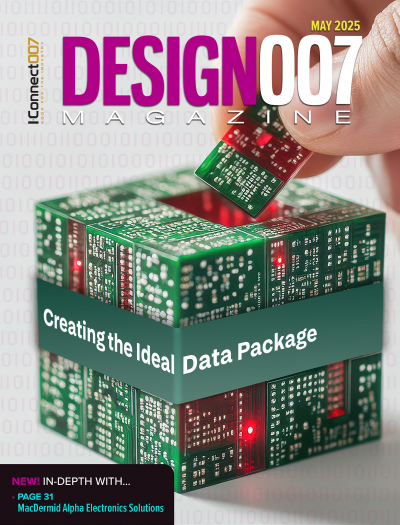-

- News
- Books
Featured Books
- design007 Magazine
Latest Issues
Current Issue
Showing Some Constraint
A strong design constraint strategy carefully balances a wide range of electrical and manufacturing trade-offs. This month, we explore the key requirements, common challenges, and best practices behind building an effective constraint strategy.

All About That Route
Most designers favor manual routing, but today's interactive autorouters may be changing designers' minds by allowing users more direct control. In this issue, our expert contributors discuss a variety of manual and autorouting strategies.

Creating the Ideal Data Package
Why is it so difficult to create the ideal data package? Many of these simple errors can be alleviated by paying attention to detail—and knowing what issues to look out for. So, this month, our experts weigh in on the best practices for creating the ideal design data package for your design.
- Articles
- Columns
- Links
- Media kit
||| MENU - design007 Magazine
Estimated reading time: 3 minutes
The Pulse Design: Constraints for the Next Generation
In Europe, where engineering careers were once seen as unpopular and lacking street credibility, we have been witnessing a turnaround in the past few years. The industry is now welcoming a new cohort of designers and engineers as people are showing a newfound interest in the profession.
What Happened?
Perhaps careers in the media or arts have lost some of their lure, and the engaging engineering content on YouTube is sparking the imaginations of a new generation of engineers and scientists. This shift has come not a moment too soon, especially in Europe, where an ageing, enthusiastic but dwindling engineering workforce was heralding the demise of the industry. Now, it feels as though the tide has turned and a growing number of high school students are seeking careers in STEM (science, technology, engineering, and mathematics).
New Chemistries, New Processes
New entrants to the industry drive innovative ideas and enthusiasm. However, the “old hands” carry a lifetime of knowledge and awareness of the pitfalls of the enthusiasm of youth. Combine the two, and our industry has a bright future. The mix of experience and open-mindedness makes for an innovative culture.
Sharing the Learning
When writing my recent book, More Secrets of High-speed PCBs, I hadn’t considered it a medium for passing inside knowledge to the next generation of PCB designers and fabricators. I aimed at PCB designers and specifiers who wanted to learn how to navigate our complex supply chains as materials and products weave from one country to another during the manufacturing process. However, to my surprise, at a recent Rick Hartley class, Neil Chamberlain, Polar’s signal integrity product manager, noted that during coffee breaks, millennial and Gen Alpha budding PCB designers didn’t look at their cell phones; they immersed themselves in More Secrets. Perhaps there is still life in ink on paper.
As in most of my columns, much of the information in More Secrets concerns what happens to your design once it is outside the comforting world of a CAD system and immersed in the practical challenges of an etch process or a substitute material from a new or alternate supplier. Students and recent graduates will have little exposure to this until they chance on the first design that doesn’t behave as the data says it should.
Embracing More Materials
One topic both new and existing designers need to concern themselves with is the proliferation of new base materials and new ways of putting them together. In a previous article on UHDI, I noted how sub-20 micron designs require major factory (new factory?) investments and therefore are limited to high volume, or specialist applications where the fabricator has government funding to move ahead. However, new chemistries are enabling a bridge down from the 75-micron limits of traditional HDI to 20 microns or so with new plating lines and chemistries, but without the cleanrooms and vast learning curve of sub-20-micron technology.
One speaker at the recent summer EIPC conference in Edinburgh referred to SAP as a learning cliff: mSAP and advanced mSAP, which operate in the 75-to-20-micron line width arena, are a learning curve rather than the cliff experience of SAP. To meet the challenges of these smaller line widths, new materials with thinner foils, thinner cores, and prepregs are required. The breadth of materials seems relentless, and at Polar, we must constantly keep our material partner libraries updated.
Conclusion
A new young cohort of PCB professionals is emerging with an arsenal of powerful tools to deploy compared with previous generations. However, experience is still required to fully understand the industry’s embedded knowledge, especially as today’s engineers must navigate more materials and build-up scenarios than ever before in PCB history.
Martyn is the author of The Printed Circuit Designer’s Guide to… Secrets of High-Speed PCBs, Parts 1 and 2, and The Printed Circuit Designer's Guide to... More Secrets of High-Speed PCBs.
This column originally appeared in the July 2025 issue of Design007 Magazine.
More Columns from The Pulse
The Pulse: Ultra Upgrade Unknowns—What’s Coming for UHDI?The Pulse: Commonsense Cost Cutting
The Pulse: Overconstraining: Short, Slim, and Smooth
The Pulse: Drilling Down on Documentation
The Pulse: New Designer’s (Partial) Guide to Fabrication
The Pulse: Simplest Stackups Specified
The Pulse: Rough Roughness Reasoning
The Pulse: Industry Organizations Keep Knowledge Alive


